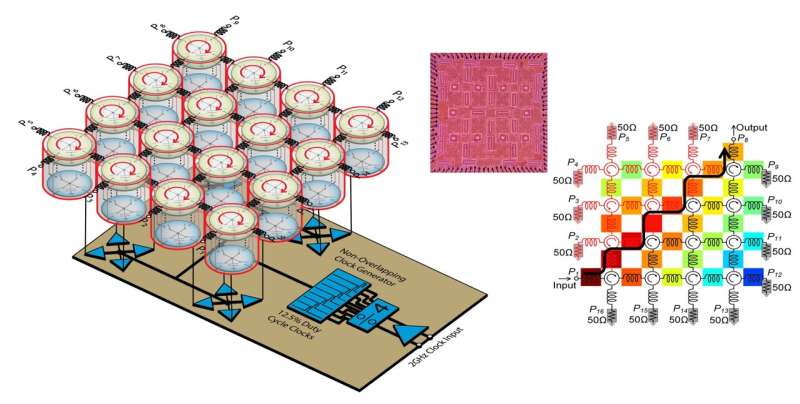This schematic (left) shows the implementation of our Floquet PTI, the image in the middle shows the actual device, and on the right we show measurements demonstrating the robust propagation of electromagnetic signals across the device. Credit: Nagulu et al.
Floquet topological insulators are materials with topological phases that originate from tailored time-dependent perturbations of their crystal structure. These materials have been proved to feature highly unusual electron conduction properties. In recent years, there has been significant interest in exploring analogous features for electromagnetic waves using tailored metamaterials, which promise exciting opportunities for a wide range of applications, including the development of wireless communication, radar and quantum technology.
Researchers at Columbia University, City University of New York, and the University of Texas at Austin have recently introduced Floquet topological insulators for radio-waves with a unique design, based on the quasi-electrostatic propagation of radio signals in switched-capacitor networks. Their paper, published in Nature Electronics, builds on the team's previous work focusing on photonic topological insulators (PTIs), a class of materials that can guide light in unusual and advantageous ways.
"Prof. Alu and I have both been very active in the area of time-modulated materials and circuits," Harish Krishnaswamy, one of the researchers who carried out the study, told Phys.org. "These are materials or circuits where some parameter is varied in time. Such time-modulated materials or circuits can break several fundamental limits associated with static materials or circuits. For example, one can achieve non-reciprocity, where signals travel in different ways in forward and reverse directions, to build non-reciprocal components such as circulators and isolators."
The notion of building a time-modulated, non-reciprocal circulator could be extended to the design of topological insulators, by connecting many circulators in a lattice. While material scientists had previously explored this idea from a theoretical standpoint, so far it had never been experimentally demonstrated. A key reason for this is that building many time-modulated circulators in a robust and generalizable fashion, and connecting them, is a challenging task, and so far these devices featured a moderate bandwidth of operation. As part of their study, Krishnaswamy and his colleagues were able to successfully integrate these time-modulated circulators on a silicon chip and dramatically extending their bandwidth of operation based on their quasi-electrostatic nature.
"Integrated circuits are a powerful platform to build complex time-modulated circuits with many elements in a robust and repeatable fashion," Krishnaswamy said. "So naturally, the questions that arose were: 1) can we build a time-modulated non-reciprocal topological insulator on a chip? 2) what practical applications would it be useful for?"
The PTI chip developed by the researchers could be used to create full-duplex phased-array wireless technology, which combines two different 5G wireless capabilities: full-duplex and multi-antenna operation. In their paper, the team indeed demonstrated the feasibility of their chip for the fabrication of multi-antenna ultra-wideband impulse radar technology.
"PTIs do not allow the propagation of electromagnetic waves in their bulk, but they ensure efficient and robust wave propagation on their boundaries, however shaped," Andrea Alu, another researcher involved in the study, told TechXplore. "These unusual features are ensured by specific forms of broken symmetry that characterize the microstructure of these artificial materials."
Over the past decade or so, researchers developed different types of PTIs, most of which rely on broken symmetries in space. In contrast, the PTI chips developed by Krishnaswamy, Alu and their colleagues relies on the breaking of time symmetry. This was hypothesized by the team and other research groups to be a promising approach to attain more robust electromagnetic wave propagation on the boundaries of the devices, as it would ensure one-way propagation and prevent back reflections.
"Our experimental demonstration is the first of such class of PTIs for electromagnetic waves, in which the broken symmetry in time is obtained by changing the material properties temporally with tailored modulation patterns," Alu explained. "This solution has several benefits: it enables robust one-way signal propagation along arbitrary boundaries, supports bandwidths much larger than any previous demonstration of a PTI, and an extremely compact form factor."
The recent study carried out by this team of researchers could have notable implications for the development of wireless communication tools and other state-of-the-art technologies. The new form of electromagnetic wave propagation demonstrated in their study and the Floquet PTI chip they developed could soon be integrated and evaluated in various devices.
"The unique features mentioned above, i.e., its robustness, large bandwidth, and extremely compact form factor, are ideally suited for enhancing communication systems, as we demonstrate in the paper in a couple of relevant applications," Alu added. "We are exploring the implementation of these devices in practical wireless systems to enhance the quality of cell phone communications and radar systems."
More information: Aravind Nagulu et al, Chip-scale Floquet topological insulators for 5G wireless systems, Nature Electronics (2022). DOI: 10.1038/s41928-022-00751-9
Journal information: Nature Electronics
© 2022 Science X Network
























